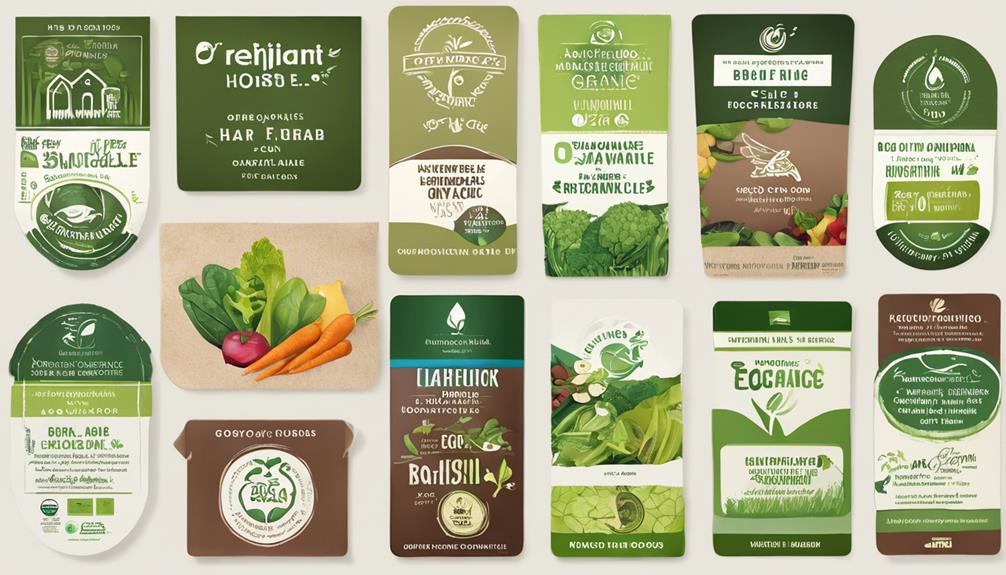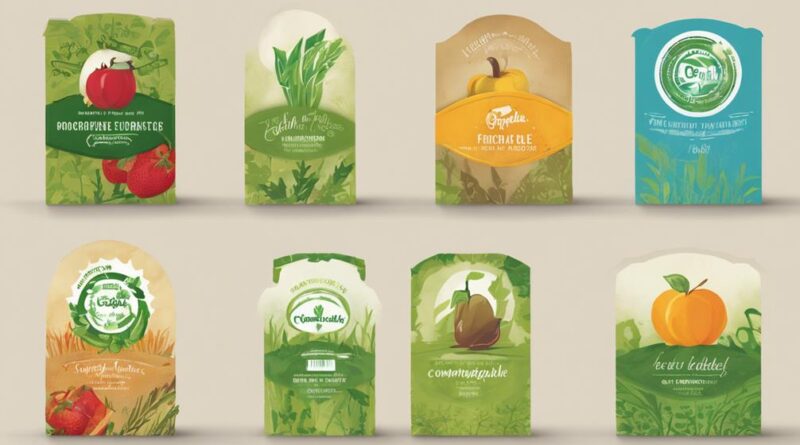7 Best Practices for Eco-Friendly Food Packaging Labels
To enhance your eco-friendly food packaging, follow these seven best practices for sustainable labels. Embrace eco-friendly labels for sustainability and consumer trust. Incorporate clear organic certification logos for transparency. Opt for a minimalistic design to appeal to eco-conscious consumers. Use biodegradable materials to reduce environmental impact. Include recycling instructions for proper disposal methods. Promote biodiversity and soil health in your practices. Ensure supply chain transparency with ethical sourcing. By reducing your carbon footprint and complying with organic labeling regulations, you'll show commitment to sustainability and connect with environmentally conscious consumers, further enhancing your brand's eco-friendly image.
Importance of Eco-Friendly Labels
Embracing eco-friendly labels on food packaging is crucial for fostering sustainability and addressing environmental concerns in the modern consumer market. Green marketing has become increasingly important as consumers are becoming more conscious of the environmental impact of their choices. By utilizing eco-friendly labels on food packaging, companies can showcase their commitment to sustainability and attract environmentally-conscious consumers.
One significant aspect of eco-friendly labels is their ability to communicate a brand's dedication to reducing its environmental impact. Consumers are more likely to choose products with eco-friendly packaging, as it reflects a company's values and commitment to environmental stewardship. This can lead to increased brand loyalty and positive brand perception, ultimately driving sales and market share.
Moreover, eco-friendly labels play a crucial role in educating consumers about the environmental benefits of choosing sustainable packaging options. By including information about the recyclability or biodegradability of the packaging materials, companies can raise awareness about the importance of making eco-conscious choices. This not only empowers consumers to make informed decisions but also encourages them to prioritize sustainability in their purchasing behavior.
Clear Organic Certification Logos
To enhance consumer trust and promote transparency in environmental claims, incorporating clear organic certification logos on food packaging is pivotal for communicating authenticity and meeting the growing demand for organic products. Sustainability impact is a key factor driving the need for these logos. By displaying recognized organic certification logos such as USDA Organic or EU Organic, food companies can showcase their commitment to sustainable practices, reassuring consumers about the origins and processing methods of the products.
These logos not only assure consumers of the organic status of the food but also provide insight into the sustainability impact of the packaging. For instance, products carrying these logos often adhere to standards that promote eco-friendly packaging materials and practices, further aligning with consumer expectations for environmentally conscious choices. This additional layer of information contributes to consumer transparency, allowing individuals to make informed decisions based on the entire lifecycle of the product, from sourcing to disposal.
Incorporating clear organic certification logos on food packaging goes beyond just meeting regulatory requirements; it demonstrates a proactive approach towards sustainability and consumer trust. As the demand for organic products continues to rise, these logos serve as a visual cue for consumers seeking products that align with their values of environmental responsibility and health consciousness.
Minimalistic Design Approach
How can a minimalistic design approach revolutionize eco-friendly food packaging labels?
When it comes to sustainable branding and enhancing consumer appeal, adopting a visual simplicity can make a significant impact. By stripping away unnecessary elements and focusing on essential information, a minimalistic design approach not only reduces visual clutter but also aligns well with eco-friendly values.
Sustainable branding is all about communicating a commitment to environmental responsibility. A minimalistic design approach can help achieve this by conveying a sense of elegance and conscientiousness. Through clean lines, ample white space, and restrained use of colors, eco-friendly food packaging labels can exude a modern and eco-conscious vibe that resonates with environmentally conscious consumers.
Visual simplicity is key to capturing the attention of consumers in a cluttered marketplace. By employing a minimalistic design approach, important information such as organic certifications, recycling instructions, or sustainability pledges can stand out prominently. This not only enhances the visibility of crucial details but also reinforces the brand's dedication to transparency and environmental stewardship.
Use of Biodegradable Materials
The shift towards eco-friendly food packaging labels can be further advanced through the incorporation of biodegradable materials, enhancing sustainability efforts and reducing environmental impact. When considering biodegradable alternatives, it's essential to choose materials that break down naturally, minimizing harm to the environment. Here are some key points to guide the use of biodegradable materials in food packaging labels:
- Selecting Suitable Biodegradable Alternatives: Opt for materials such as PLA (polylactic acid), bagasse (sugarcane fiber), or compostable paper for packaging labels. These options offer a sustainable alternative to traditional non-biodegradable materials.
- Understanding Decomposition Rates: Different biodegradable materials break down at varying rates. Consider the product's lifecycle and choose materials that align with the decomposition timeline needed for the specific packaging.
- Certifications and Standards: Look for certifications like the Biodegradable Products Institute (BPI) certification or the European Standard EN 13432 to ensure the chosen materials meet established biodegradability standards.
- Educating Consumers: Clearly communicate the benefits of using biodegradable materials on the packaging labels. Educating consumers about the environmental impact of their choices can encourage more sustainable practices.
Incorporating Recycling Instructions
Incorporating clear and concise recycling instructions on food packaging labels enhances consumer awareness and promotes sustainable waste management practices. When designing packaging labels, it's crucial to include specific recycling instructions that inform consumers how to properly dispose of the packaging materials. Clearly labeled recycling instructions such as 'Please recycle this box in your local recycling bin' or 'Separate this plastic wrap for recycling' guide consumers on the appropriate disposal methods, thereby encouraging them to participate in sustainable practices.
To effectively communicate recycling instructions, consider using universally recognized recycling symbols alongside written guidance. These symbols provide a visual cue that quickly conveys the recyclability of the packaging material. Additionally, incorporating sustainable messaging within the recycling instructions can further emphasize the importance of eco-conscious behavior. Phrases like 'Join us in reducing waste by recycling this packaging' or 'Help protect the environment – recycle responsibly' can reinforce the message of sustainability to consumers.
Incorporating recycling instructions not only educates consumers on proper waste management but also aligns your brand with eco-friendly values. By embracing sustainable packaging practices and clearly communicating recycling guidelines, you can foster a sense of environmental responsibility among consumers and contribute to a greener future. Remember, every small step towards sustainable packaging makes a significant impact on our planet's health.
Highlighting Sustainable Sourcing
Wondering where your food packaging materials come from and how they impact the environment? When it comes to highlighting sustainable sourcing on your food packaging labels, it's essential to consider ethical farming practices and the overall environmental impact.
- Ethical Farming Practices: Choose suppliers that prioritize ethical farming methods. This includes supporting farmers who pay fair wages, provide good working conditions, and use sustainable agricultural practices that promote biodiversity and soil health.
- Supply Chain Transparency: Ensure transparency in your supply chain by providing information on where your ingredients are sourced. Highlight partnerships with local farmers or organizations that promote sustainable agriculture and ethical sourcing practices.
- Certifications: Display relevant certifications on your packaging labels to assure consumers that your products are sourced ethically and sustainably. Certifications such as Fair Trade, Rainforest Alliance, or USDA Organic can help build trust with environmentally conscious consumers.
- Reduced Carbon Footprint: Consider the transportation and energy usage involved in sourcing your ingredients. Opt for locally sourced ingredients when possible to reduce the carbon footprint associated with transportation and support local economies.
Complying With Organic Labeling Regulations

To ensure your food packaging aligns with organic labeling regulations, meticulous attention to detail in sourcing and certification processes is paramount. Maintaining labeling accuracy is essential to building consumer trust in your eco-friendly products. The first step is to source ingredients from certified organic suppliers. Verify that these suppliers adhere to organic farming practices and have the necessary certifications. Keep thorough records of these certifications to demonstrate compliance with organic labeling standards.
When designing your packaging labels, ensure that any claims of organic ingredients are accurate and in line with organic labeling regulations. Use clear and specific language to describe the organic components of your product. Avoid vague terms that could mislead consumers about the organic content of your food items. Consumers rely on accurate labeling to make informed purchasing decisions, so transparency is key to building trust.
Regularly review and update your packaging labels to reflect any changes in sourcing or certifications. Stay informed about updates to organic labeling regulations to ensure ongoing compliance. By prioritizing labeling accuracy and consumer trust, you can establish your brand as a reliable source of eco-friendly and organically produced food products.
Conclusion
In conclusion, following these 7 best practices for eco-friendly food packaging labels can help your brand showcase its commitment to sustainability and environmentally-friendly practices.
By incorporating clear organic certification logos, using biodegradable materials, and highlighting sustainable sourcing, you can appeal to eco-conscious consumers and make a positive impact on the planet.
Remember to always comply with organic labeling regulations and provide recycling instructions to further enhance your eco-friendly packaging efforts.
